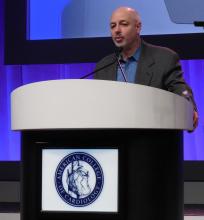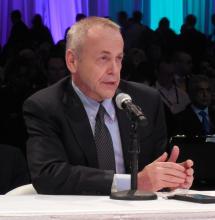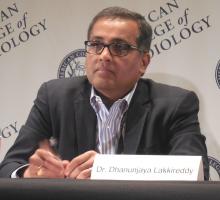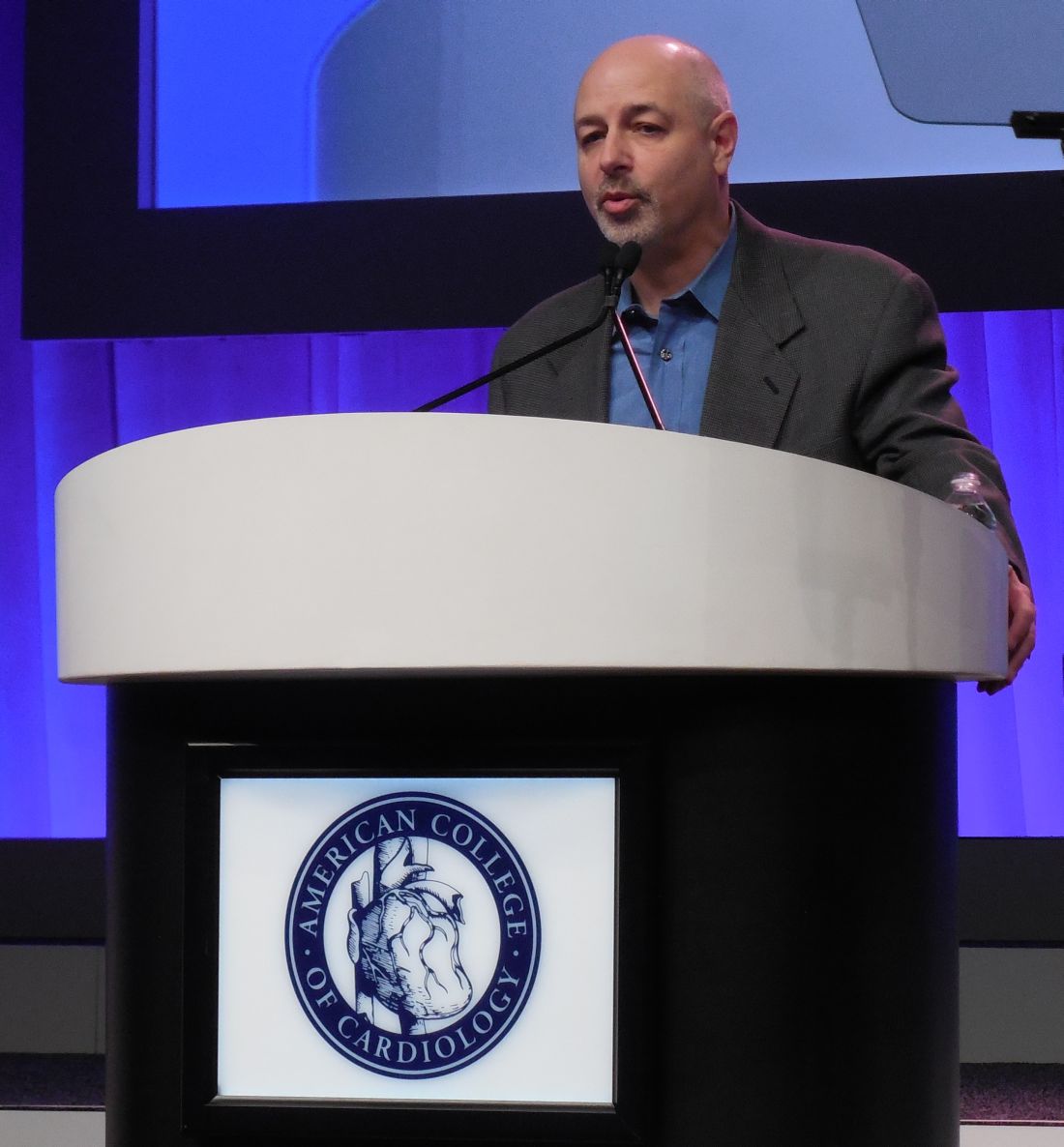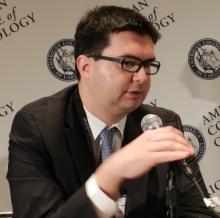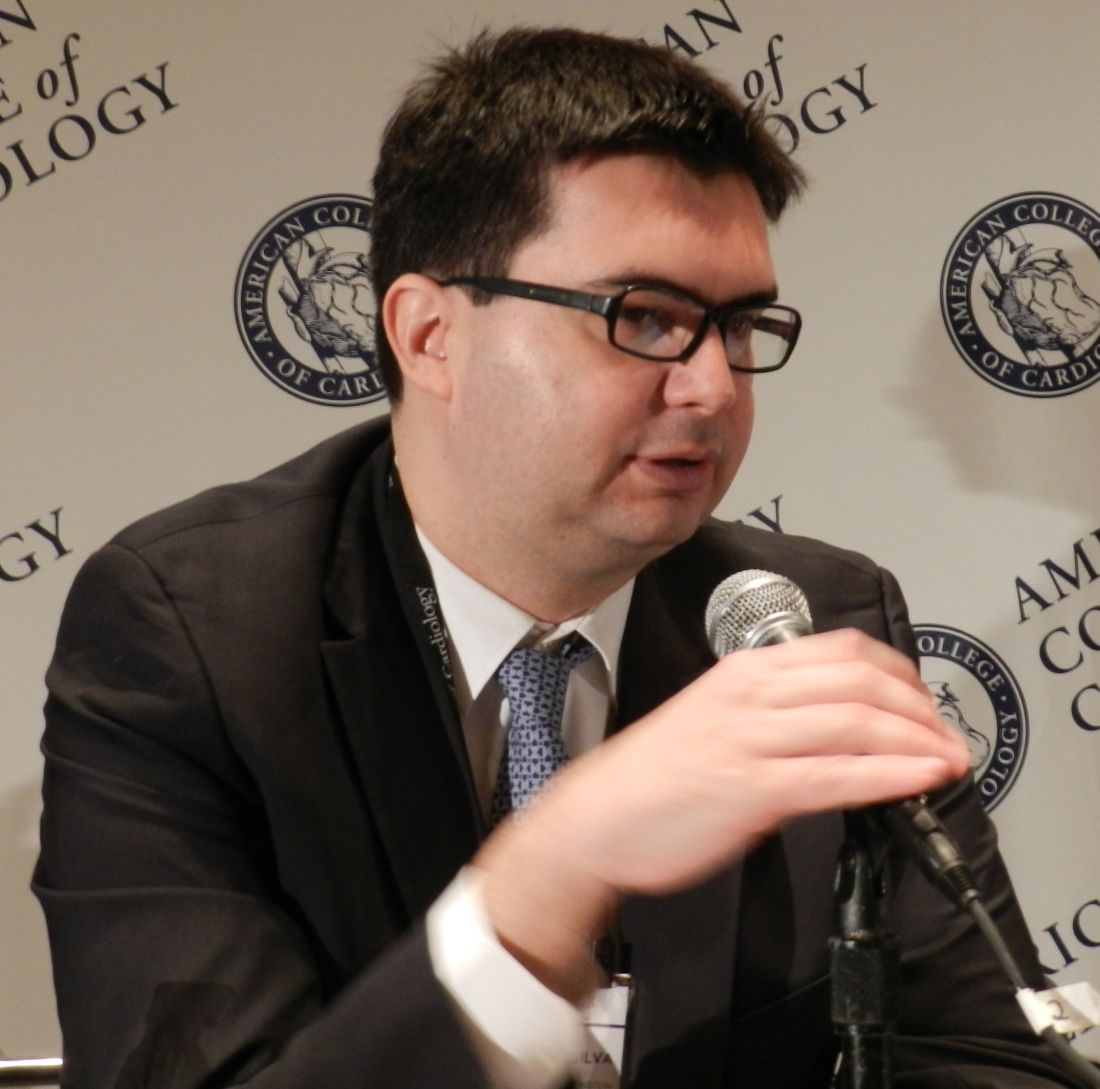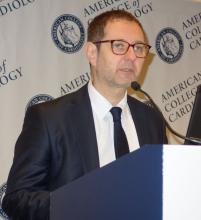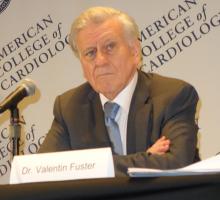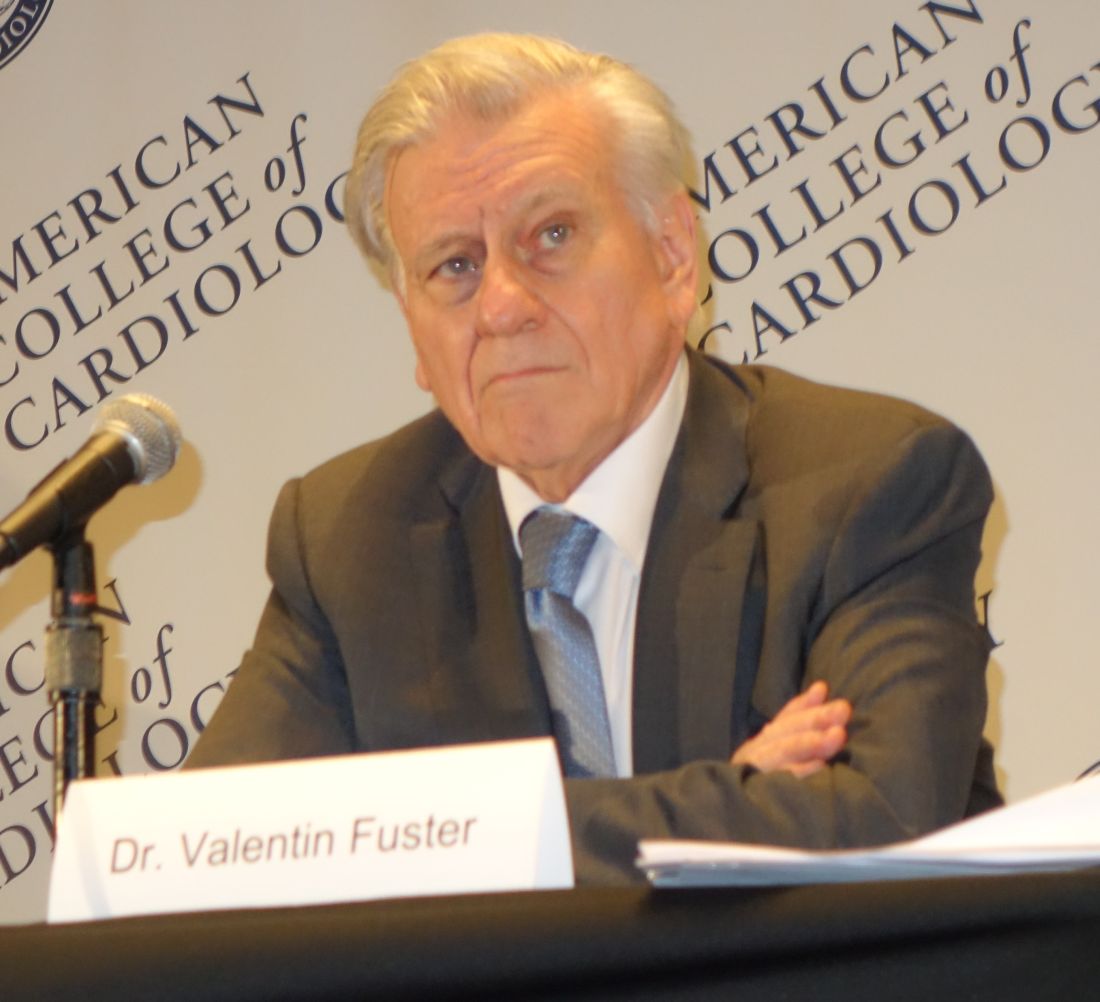User login
Genotype did not significantly affect evacetrapib response
Evacetrapib missed its primary MACE endpoint compared with placebo among patients with high-risk vascular disease, including those who were homozygous (AA) for polymorphism rs1967309 of the ADCY gene, in a large nested case-control analysis of the ACCELERATE trial.
The results contradict those for another cholesteryl ester transfer protein (CETP) inhibitor – dalcetrapib – which has shown significant cardiovascular benefits only among AA patients.
“Although directionally similar to the dalcetrapib analysis, there was no significant interaction between genotype and cardiovascular outcome with evacetrapib,” Steven E. Nissen, MD, and his associates wrote simultaneously in JAMA Cardiology and reported at the annual meeting of the American College of Cardiology.
Four CETP inhibitors have reached full-scale development: evacetrapib, dalcetrapib, torcetrapib, and anacetrapib. They all markedly increase circulating HDL, and all except dalcetrapib cut circulating LDL. But those benefits largely haven’t extended to the key endpoint, major adverse cardiovascular events (MACE). In large trials, torcetrapib increased MACE, anacetrapib reduced MACE by such a small amount that its maker did not file for FDA approval, and evacetrapib and dalcetrapib had no effect on MACE.
But there was a caveat for dalcetrapib. In a post-hoc analysis of its placebo-controlled trial, the CETP inhibitor reduced MACE by 39% among AA individuals and increased MACE by 27% among GG individuals, those homozygous negative for the SNP rs1967309.
These findings could make sense because ADCY gene variants have been linked to carotid intimal medial thickness, high-sensitivity C-reactive protein, and cholesterol efflux capacity, wrote Dr. Nissen of the department of cardiovascular medicine, Cleveland Clinic, Cleveland, Ohio (JAMA Cardiol. 2018 Mar 11. doi: 10.1001/jamacardio.2018.0569).
To explore whether ADCY genotypep also affects evacetrapib response, he and his associates compared 1,427 cases with MACE with 1,532 matched controls from the international, randomized, double-blind ACCELERATE (Assessment of Clinical Effects of Cholesteryl Ester Transfer Protein Inhibition with Evacetrapib in Patients at a High Risk for Vascular Outcomes) trial (NCT01687998). Participants had cerebrovascular atherosclerotic disease, peripheral arterial disease, coronary artery disease with diabetes, or recent acute coronary syndrome. They received oral evacetrapib (130 mg) or placebo, and the primary endpoint was a composite of cardiovascular death, myocardial infarction, stroke, coronary revascularization, or hospitalization for unstable angina.
Evacetrapib missed this primary endpoint in all genetic subgroups. Odds ratios for evacetrapib compared with placebo were 0.88 (95% confidence interval, 0.69 to 1.12) among AA patients, 1.04 (95% CI, 0.90 to 1.21) among heterozygous (AG) patients, and 1.18 (95% CI, 0.98 to 1.41) among GG patients. A test for interaction also was insignificant (P = .17). A test for trend nearly reached significance (P = .06), but weakened when the investigators controlled for cardiovascular risk factors or looked only at hard cardiovascular outcomes, they said.
Thus, the relationship between evacetrapib response and AA genotype “was far less in magnitude than observed in the pharmacogenetic study with dalcetrapib,” they wrote. Dalcetrapib is a weaker CETP inhibitor than evacetrapib, the study populations weren’t identical, and the trials used different statistical methods, all of which could explain the discrepant findings, they added. “The completion of the dalcetrapib pharmacogenetics outcome trial should clarify whether this is a false signal or a paradigm-shifting discovery.”
Eli Lilly provided funding, helped design and conduct the study, and helped write the manuscript. Dr. Nissen reported receiving grants and nonfinancial support from Eli Lilly while conducting the study. Several coinvestigators also disclosed ties to Eli Lilly and six reported being employees of the company.
Source: JAMA Cardiol. doi:10.1001/jamacardio.2018.0569.
Evacetrapib missed its primary MACE endpoint compared with placebo among patients with high-risk vascular disease, including those who were homozygous (AA) for polymorphism rs1967309 of the ADCY gene, in a large nested case-control analysis of the ACCELERATE trial.
The results contradict those for another cholesteryl ester transfer protein (CETP) inhibitor – dalcetrapib – which has shown significant cardiovascular benefits only among AA patients.
“Although directionally similar to the dalcetrapib analysis, there was no significant interaction between genotype and cardiovascular outcome with evacetrapib,” Steven E. Nissen, MD, and his associates wrote simultaneously in JAMA Cardiology and reported at the annual meeting of the American College of Cardiology.
Four CETP inhibitors have reached full-scale development: evacetrapib, dalcetrapib, torcetrapib, and anacetrapib. They all markedly increase circulating HDL, and all except dalcetrapib cut circulating LDL. But those benefits largely haven’t extended to the key endpoint, major adverse cardiovascular events (MACE). In large trials, torcetrapib increased MACE, anacetrapib reduced MACE by such a small amount that its maker did not file for FDA approval, and evacetrapib and dalcetrapib had no effect on MACE.
But there was a caveat for dalcetrapib. In a post-hoc analysis of its placebo-controlled trial, the CETP inhibitor reduced MACE by 39% among AA individuals and increased MACE by 27% among GG individuals, those homozygous negative for the SNP rs1967309.
These findings could make sense because ADCY gene variants have been linked to carotid intimal medial thickness, high-sensitivity C-reactive protein, and cholesterol efflux capacity, wrote Dr. Nissen of the department of cardiovascular medicine, Cleveland Clinic, Cleveland, Ohio (JAMA Cardiol. 2018 Mar 11. doi: 10.1001/jamacardio.2018.0569).
To explore whether ADCY genotypep also affects evacetrapib response, he and his associates compared 1,427 cases with MACE with 1,532 matched controls from the international, randomized, double-blind ACCELERATE (Assessment of Clinical Effects of Cholesteryl Ester Transfer Protein Inhibition with Evacetrapib in Patients at a High Risk for Vascular Outcomes) trial (NCT01687998). Participants had cerebrovascular atherosclerotic disease, peripheral arterial disease, coronary artery disease with diabetes, or recent acute coronary syndrome. They received oral evacetrapib (130 mg) or placebo, and the primary endpoint was a composite of cardiovascular death, myocardial infarction, stroke, coronary revascularization, or hospitalization for unstable angina.
Evacetrapib missed this primary endpoint in all genetic subgroups. Odds ratios for evacetrapib compared with placebo were 0.88 (95% confidence interval, 0.69 to 1.12) among AA patients, 1.04 (95% CI, 0.90 to 1.21) among heterozygous (AG) patients, and 1.18 (95% CI, 0.98 to 1.41) among GG patients. A test for interaction also was insignificant (P = .17). A test for trend nearly reached significance (P = .06), but weakened when the investigators controlled for cardiovascular risk factors or looked only at hard cardiovascular outcomes, they said.
Thus, the relationship between evacetrapib response and AA genotype “was far less in magnitude than observed in the pharmacogenetic study with dalcetrapib,” they wrote. Dalcetrapib is a weaker CETP inhibitor than evacetrapib, the study populations weren’t identical, and the trials used different statistical methods, all of which could explain the discrepant findings, they added. “The completion of the dalcetrapib pharmacogenetics outcome trial should clarify whether this is a false signal or a paradigm-shifting discovery.”
Eli Lilly provided funding, helped design and conduct the study, and helped write the manuscript. Dr. Nissen reported receiving grants and nonfinancial support from Eli Lilly while conducting the study. Several coinvestigators also disclosed ties to Eli Lilly and six reported being employees of the company.
Source: JAMA Cardiol. doi:10.1001/jamacardio.2018.0569.
Evacetrapib missed its primary MACE endpoint compared with placebo among patients with high-risk vascular disease, including those who were homozygous (AA) for polymorphism rs1967309 of the ADCY gene, in a large nested case-control analysis of the ACCELERATE trial.
The results contradict those for another cholesteryl ester transfer protein (CETP) inhibitor – dalcetrapib – which has shown significant cardiovascular benefits only among AA patients.
“Although directionally similar to the dalcetrapib analysis, there was no significant interaction between genotype and cardiovascular outcome with evacetrapib,” Steven E. Nissen, MD, and his associates wrote simultaneously in JAMA Cardiology and reported at the annual meeting of the American College of Cardiology.
Four CETP inhibitors have reached full-scale development: evacetrapib, dalcetrapib, torcetrapib, and anacetrapib. They all markedly increase circulating HDL, and all except dalcetrapib cut circulating LDL. But those benefits largely haven’t extended to the key endpoint, major adverse cardiovascular events (MACE). In large trials, torcetrapib increased MACE, anacetrapib reduced MACE by such a small amount that its maker did not file for FDA approval, and evacetrapib and dalcetrapib had no effect on MACE.
But there was a caveat for dalcetrapib. In a post-hoc analysis of its placebo-controlled trial, the CETP inhibitor reduced MACE by 39% among AA individuals and increased MACE by 27% among GG individuals, those homozygous negative for the SNP rs1967309.
These findings could make sense because ADCY gene variants have been linked to carotid intimal medial thickness, high-sensitivity C-reactive protein, and cholesterol efflux capacity, wrote Dr. Nissen of the department of cardiovascular medicine, Cleveland Clinic, Cleveland, Ohio (JAMA Cardiol. 2018 Mar 11. doi: 10.1001/jamacardio.2018.0569).
To explore whether ADCY genotypep also affects evacetrapib response, he and his associates compared 1,427 cases with MACE with 1,532 matched controls from the international, randomized, double-blind ACCELERATE (Assessment of Clinical Effects of Cholesteryl Ester Transfer Protein Inhibition with Evacetrapib in Patients at a High Risk for Vascular Outcomes) trial (NCT01687998). Participants had cerebrovascular atherosclerotic disease, peripheral arterial disease, coronary artery disease with diabetes, or recent acute coronary syndrome. They received oral evacetrapib (130 mg) or placebo, and the primary endpoint was a composite of cardiovascular death, myocardial infarction, stroke, coronary revascularization, or hospitalization for unstable angina.
Evacetrapib missed this primary endpoint in all genetic subgroups. Odds ratios for evacetrapib compared with placebo were 0.88 (95% confidence interval, 0.69 to 1.12) among AA patients, 1.04 (95% CI, 0.90 to 1.21) among heterozygous (AG) patients, and 1.18 (95% CI, 0.98 to 1.41) among GG patients. A test for interaction also was insignificant (P = .17). A test for trend nearly reached significance (P = .06), but weakened when the investigators controlled for cardiovascular risk factors or looked only at hard cardiovascular outcomes, they said.
Thus, the relationship between evacetrapib response and AA genotype “was far less in magnitude than observed in the pharmacogenetic study with dalcetrapib,” they wrote. Dalcetrapib is a weaker CETP inhibitor than evacetrapib, the study populations weren’t identical, and the trials used different statistical methods, all of which could explain the discrepant findings, they added. “The completion of the dalcetrapib pharmacogenetics outcome trial should clarify whether this is a false signal or a paradigm-shifting discovery.”
Eli Lilly provided funding, helped design and conduct the study, and helped write the manuscript. Dr. Nissen reported receiving grants and nonfinancial support from Eli Lilly while conducting the study. Several coinvestigators also disclosed ties to Eli Lilly and six reported being employees of the company.
Source: JAMA Cardiol. doi:10.1001/jamacardio.2018.0569.
FROM ACC 2018
Key clinical point: Evacetrapib missed its primary MACE endpoint compared with placebo among patients with high-risk vascular disease, including those who were homozygous (AA) for polymorphism rs1967309 of the ADCY gene.
Major finding: Odds ratios for evacetrapib compared with placebo were 0.88 (95% confidence interval, 0.69 to 1.12) among AA patients; 1.04 (95% CI, 0.90 to 1.21) among heterozygous (AG) patients; and 1.18 (95% CI, 0.98 to 1.41) among GG patients. P-values for tests for trend exceeded .05.
Data source: A nested study of 1,427 cases with major adverse cardiovascular events and 1,532 matched controls from the ACCELERATE trial.
Disclosures: Eli Lilly provided funding and was involved in all aspects of the study and manuscript preparation. Dr. Nissen reported receiving grants and nonfinancial support from Eli Lilly while conducting the study. Several coinvestigators also disclosed ties to Eli Lilly and six reported being employees of the company.
Source: JAMA Cardiol. doi:10.1001/jamacardio.2018.0569.
Wearable defibrillator cuts mortality in post-MI patients
ORLANDO – Wearable cardioverter defibrillator vests failed to significantly cut the rate of arrhythmic death in at-risk post-MI patients but succeeded in significantly dropping total mortality during a median of 84 days of use in the first randomized trial of nonimplanted defibrillators in such patients.
But despite this overall mortality benefit, the 1,524 patients randomized to the WCD group failed to show a significant improvement in the rate of sudden and ventricular tachycardia death, the primary endpoint for the study, said Dr. Olgin, chief of cardiology at the University of California, San Francisco. Total mortality was a secondary endpoint in the study. Based on the total mortality benefit observed and the “totality of evidence” from prior, uncontrolled observational studies, Dr. Olgin concluded that it is now “reasonable” to protect post-MI patients with ejection fractions of 35% or less during the first 40-90 days following an MI when patients can then be assessed for receiving an implantable cardioverter defibrillator.
That would be an upgrade from the current American College of Cardiology/American Heart Association guidelines on managing ventricular arrhythmias and preventing sudden cardiac death, issued in 2017, that classified WCDs as a class IIb recommendations – “may be reasonable” – for post-MI patients with a reduced left ventricular ejection fraction (Circulation. 2017 Oct 30;doi:10.1161/CIR.0000000000000549).
WCDs are currently approved for routine prescribing by U.S. physicians, but their use is very variable in post-MI patients. Just before Dr. Olgin delivered his report at the meeting, a poll of the several thousand meeting attendees who heard his talk showed that roughly a third reported routinely prescribing WCDs, with the other two thirds saying they did not.
Several electrophysiologists who heard the report agreed that further research needs to better tease out which post-MI patients get the most benefit from this treatment.
The patients enrolled in the study “were not a sick population; they had a low event rate,” commented Sana M. Al-Khatib, MD, professor of medicine at Duke University in Durham, N.C. and chair of the panel that wrote the 2017 ventricular arrhythmia guidelines. She suggested testing the efficacy of WCDs in post-MI patients with lower ejection fractions or those with a greater history of heart disease prior to their index MI. Nearly half of the patients enrolled in the study had New York Heart Association class I symptoms, indicating that they had mild heart disease, she noted in an interview. Another issue left unresolved by the results Dr. Olgin reported was how much of the mortality benefit was attributable to the shocks delivered by the tested WCDs and how much derived from the arrhythmia monitoring that the WCDs provided.
Another way to better target WCDs to post-MI patients who could derive the most benefit might be to focus on patients with frequent premature ventricular contractions and nonsustained ventricular tachycardia, suggested Dhanunjaya Lakkireddy, MD, professor of medicine and director of the Center for Excellence in AF and Complex Arrhythmias at the University of Kansas Medical Center in Kansas City. But Dr. Lakkireddy acknowledged that currently left ventricular ejection fraction is the primary surrogate marker cardiologists rely on to identify post-MI patients who are at increased risk for ventricular arrhythmia.
Dr. Olgin countered that the total mortality rate seen among the control, usual care patients in his study, 4.9% during the median 84 day follow-up, closely matched the 5% rate reported in prior trials of at-risk patients who received implantable cardioverter defibrillators.
During follow-up, total mortality occurred in 3.1% of the patients randomized to WCD use and 4.9% among the control patients.
The results also showed that 19% of the patients randomized to the WCD arm failed to ever use the device, and that over the course of follow-up the usage rate fell below 50%. Patients who used the device generally wore it as directed, however, with an average 22 hours a day of use at the start of treatment that subsequently dipped to 21 hours a day near the end of the 90-day treatment period, Dr. Olgin reported.
The most likely explanation for the disparity between the significant effect on total mortality and the insignificant effect on arrhythmia mortality is misclassification of some deaths. “Any small number of misclassified sudden deaths would have dramatically reduced our power to see a difference” in arrhythmia deaths, Dr. Olgin noted.
VEST was sponsored by Zoll, the company that markets the tested device. Dr. Olgin has no personal disclosures. Dr. Al-Khatib and Dr. Lakkireddy had no disclosures. Dr. Wilber is a consultant to Biosense Webster and Medtronic.
mzoler@frontlinemedcom.com
SOURCE: Olgin J et al. ACC 18.
ORLANDO – Wearable cardioverter defibrillator vests failed to significantly cut the rate of arrhythmic death in at-risk post-MI patients but succeeded in significantly dropping total mortality during a median of 84 days of use in the first randomized trial of nonimplanted defibrillators in such patients.
But despite this overall mortality benefit, the 1,524 patients randomized to the WCD group failed to show a significant improvement in the rate of sudden and ventricular tachycardia death, the primary endpoint for the study, said Dr. Olgin, chief of cardiology at the University of California, San Francisco. Total mortality was a secondary endpoint in the study. Based on the total mortality benefit observed and the “totality of evidence” from prior, uncontrolled observational studies, Dr. Olgin concluded that it is now “reasonable” to protect post-MI patients with ejection fractions of 35% or less during the first 40-90 days following an MI when patients can then be assessed for receiving an implantable cardioverter defibrillator.
That would be an upgrade from the current American College of Cardiology/American Heart Association guidelines on managing ventricular arrhythmias and preventing sudden cardiac death, issued in 2017, that classified WCDs as a class IIb recommendations – “may be reasonable” – for post-MI patients with a reduced left ventricular ejection fraction (Circulation. 2017 Oct 30;doi:10.1161/CIR.0000000000000549).
WCDs are currently approved for routine prescribing by U.S. physicians, but their use is very variable in post-MI patients. Just before Dr. Olgin delivered his report at the meeting, a poll of the several thousand meeting attendees who heard his talk showed that roughly a third reported routinely prescribing WCDs, with the other two thirds saying they did not.
Several electrophysiologists who heard the report agreed that further research needs to better tease out which post-MI patients get the most benefit from this treatment.
The patients enrolled in the study “were not a sick population; they had a low event rate,” commented Sana M. Al-Khatib, MD, professor of medicine at Duke University in Durham, N.C. and chair of the panel that wrote the 2017 ventricular arrhythmia guidelines. She suggested testing the efficacy of WCDs in post-MI patients with lower ejection fractions or those with a greater history of heart disease prior to their index MI. Nearly half of the patients enrolled in the study had New York Heart Association class I symptoms, indicating that they had mild heart disease, she noted in an interview. Another issue left unresolved by the results Dr. Olgin reported was how much of the mortality benefit was attributable to the shocks delivered by the tested WCDs and how much derived from the arrhythmia monitoring that the WCDs provided.
Another way to better target WCDs to post-MI patients who could derive the most benefit might be to focus on patients with frequent premature ventricular contractions and nonsustained ventricular tachycardia, suggested Dhanunjaya Lakkireddy, MD, professor of medicine and director of the Center for Excellence in AF and Complex Arrhythmias at the University of Kansas Medical Center in Kansas City. But Dr. Lakkireddy acknowledged that currently left ventricular ejection fraction is the primary surrogate marker cardiologists rely on to identify post-MI patients who are at increased risk for ventricular arrhythmia.
Dr. Olgin countered that the total mortality rate seen among the control, usual care patients in his study, 4.9% during the median 84 day follow-up, closely matched the 5% rate reported in prior trials of at-risk patients who received implantable cardioverter defibrillators.
During follow-up, total mortality occurred in 3.1% of the patients randomized to WCD use and 4.9% among the control patients.
The results also showed that 19% of the patients randomized to the WCD arm failed to ever use the device, and that over the course of follow-up the usage rate fell below 50%. Patients who used the device generally wore it as directed, however, with an average 22 hours a day of use at the start of treatment that subsequently dipped to 21 hours a day near the end of the 90-day treatment period, Dr. Olgin reported.
The most likely explanation for the disparity between the significant effect on total mortality and the insignificant effect on arrhythmia mortality is misclassification of some deaths. “Any small number of misclassified sudden deaths would have dramatically reduced our power to see a difference” in arrhythmia deaths, Dr. Olgin noted.
VEST was sponsored by Zoll, the company that markets the tested device. Dr. Olgin has no personal disclosures. Dr. Al-Khatib and Dr. Lakkireddy had no disclosures. Dr. Wilber is a consultant to Biosense Webster and Medtronic.
mzoler@frontlinemedcom.com
SOURCE: Olgin J et al. ACC 18.
ORLANDO – Wearable cardioverter defibrillator vests failed to significantly cut the rate of arrhythmic death in at-risk post-MI patients but succeeded in significantly dropping total mortality during a median of 84 days of use in the first randomized trial of nonimplanted defibrillators in such patients.
But despite this overall mortality benefit, the 1,524 patients randomized to the WCD group failed to show a significant improvement in the rate of sudden and ventricular tachycardia death, the primary endpoint for the study, said Dr. Olgin, chief of cardiology at the University of California, San Francisco. Total mortality was a secondary endpoint in the study. Based on the total mortality benefit observed and the “totality of evidence” from prior, uncontrolled observational studies, Dr. Olgin concluded that it is now “reasonable” to protect post-MI patients with ejection fractions of 35% or less during the first 40-90 days following an MI when patients can then be assessed for receiving an implantable cardioverter defibrillator.
That would be an upgrade from the current American College of Cardiology/American Heart Association guidelines on managing ventricular arrhythmias and preventing sudden cardiac death, issued in 2017, that classified WCDs as a class IIb recommendations – “may be reasonable” – for post-MI patients with a reduced left ventricular ejection fraction (Circulation. 2017 Oct 30;doi:10.1161/CIR.0000000000000549).
WCDs are currently approved for routine prescribing by U.S. physicians, but their use is very variable in post-MI patients. Just before Dr. Olgin delivered his report at the meeting, a poll of the several thousand meeting attendees who heard his talk showed that roughly a third reported routinely prescribing WCDs, with the other two thirds saying they did not.
Several electrophysiologists who heard the report agreed that further research needs to better tease out which post-MI patients get the most benefit from this treatment.
The patients enrolled in the study “were not a sick population; they had a low event rate,” commented Sana M. Al-Khatib, MD, professor of medicine at Duke University in Durham, N.C. and chair of the panel that wrote the 2017 ventricular arrhythmia guidelines. She suggested testing the efficacy of WCDs in post-MI patients with lower ejection fractions or those with a greater history of heart disease prior to their index MI. Nearly half of the patients enrolled in the study had New York Heart Association class I symptoms, indicating that they had mild heart disease, she noted in an interview. Another issue left unresolved by the results Dr. Olgin reported was how much of the mortality benefit was attributable to the shocks delivered by the tested WCDs and how much derived from the arrhythmia monitoring that the WCDs provided.
Another way to better target WCDs to post-MI patients who could derive the most benefit might be to focus on patients with frequent premature ventricular contractions and nonsustained ventricular tachycardia, suggested Dhanunjaya Lakkireddy, MD, professor of medicine and director of the Center for Excellence in AF and Complex Arrhythmias at the University of Kansas Medical Center in Kansas City. But Dr. Lakkireddy acknowledged that currently left ventricular ejection fraction is the primary surrogate marker cardiologists rely on to identify post-MI patients who are at increased risk for ventricular arrhythmia.
Dr. Olgin countered that the total mortality rate seen among the control, usual care patients in his study, 4.9% during the median 84 day follow-up, closely matched the 5% rate reported in prior trials of at-risk patients who received implantable cardioverter defibrillators.
During follow-up, total mortality occurred in 3.1% of the patients randomized to WCD use and 4.9% among the control patients.
The results also showed that 19% of the patients randomized to the WCD arm failed to ever use the device, and that over the course of follow-up the usage rate fell below 50%. Patients who used the device generally wore it as directed, however, with an average 22 hours a day of use at the start of treatment that subsequently dipped to 21 hours a day near the end of the 90-day treatment period, Dr. Olgin reported.
The most likely explanation for the disparity between the significant effect on total mortality and the insignificant effect on arrhythmia mortality is misclassification of some deaths. “Any small number of misclassified sudden deaths would have dramatically reduced our power to see a difference” in arrhythmia deaths, Dr. Olgin noted.
VEST was sponsored by Zoll, the company that markets the tested device. Dr. Olgin has no personal disclosures. Dr. Al-Khatib and Dr. Lakkireddy had no disclosures. Dr. Wilber is a consultant to Biosense Webster and Medtronic.
mzoler@frontlinemedcom.com
SOURCE: Olgin J et al. ACC 18.
REPORTING FROM ACC18
Key clinical point: The first RCT of a wearable defibrillator in post-MI patients showed reduced total mortality.
Major finding: Total mortality was 3.2% in patients treated with a wearable cardioverter defibrillator and 4.9% in controls after a median of 84 days.
Study details: VEST, a multicenter, randomized trial with 2,302 patients.
Disclosures: VEST was sponsored by Zoll, the company that markets the tested device. Dr. Olgin has no personal disclosures.
Source: Olgin J. ACC 18.
Ticagrelor noninferior to clopidogrel in terms of major bleeds in STEMI
For patients under age 75 years with ST-segment elevation myocardial infarction, switching from clopidogrel to ticagrelor was noninferior to continuing clopidogrel in terms of 30-day rates of major bleeding, investigators reported at the annual meeting of the American College of Cardiology.
Rates of thrombolysis in myocardial infarction (TIMI) major bleeding through 30 days were 0.73% in the ticagrelor group and 0.69% in the clopidogrel group, for an absolute difference of 0.04% (95% confidence interval, −0.49% to 0.58%; P less than .001 for noninferiority). “However, minor bleeding was increased with ticagrelor, and there was no benefit on efficacy outcomes,” Otavio Berwanger, MD, PhD, wrote simultaneously in JAMA Cardiology, on behalf of the writing committee for the randomized, phase 3, open-label TREAT trial.
Abundant, robust data support prompt revascularization in ST-elevation myocardial infarction (STEMI), but the real world doesn’t always meet this standard, and lytics remain in wide use in many countries, noted Dr. Berwanger, Director of the Research Institute at the Heart Hospital of Sao Paulo (Brazil). In the early 2000s, two large trials showed that dual antiplatelet therapy with aspirin and clopidogrel reduced major adverse cardiovascular events in patients receiving fibrinolytics for STEMI. More recently, the Platelet Inhibition and Patient Outcomes (PLATO) study favored ticagrelor over clopidogrel for reducing cardiovascular or stroke-related death, with no increase in the risk of major bleeding, despite ticagrelor’s boxed warning.
However, PLATO excluded patients who received fibrinolytics in the 24 hours before treatment because of concerns that ticagrelor might contribute to serious or fatal bleeding. To assess this risk, Dr. Berwanger and his associates from 10 countries randomly assigned 3,799 patients with STEMI to receive either ticagrelor (180-mg loading dose; 90 mg twice daily thereafter) or clopidogrel (300-mg to 600-mg loading dose; 75 mg daily thereafter) a median of 11.4 hours after fibrinolysis. Patients averaged 58 years in age (standard deviation, 9.5 years), 77% were men, and 57% were white.
Because about 90% of patients had been pretreated with clopidogrel, the study primarily compared the effect of staying on clopidogrel with switching to ticagrelor, the investigators noted. “Our trial was an investigator- initiated trial with limited funding that did not allow a double-dummy design,” they added. “We attempted to minimize the risk of bias associated with the open-label nature of the study by performing blinded outcome adjudication.”
In terms of secondary endpoints, 23 patients (1.2%) on ticagrelor developed major bleeding according to PLATO criteria and Bleeding Academic Research Consortium (BARC) criteria, as did 26 patients (1.4%) on clopidogrel at 30-day follow-up (absolute difference, −0.18%; 95% CI, −0.89% to 0.54; P = .001 for noninferiority). Ticagrelor and clopidogrel also resembled each other in terms of fatal bleeds (0.16% versus 0.11%, respectively; P = .67) and intracranial bleeds (0.42% versus 0.37%; P = .82).
However, minimal PLATO bleeding was significantly more common with ticagrelor (3.2%) than with clopidogrel (2%; P = .02), the researchers reported. Clinically significant TIMI bleeding requiring medical attention occurred in 2% of the ticagrelor group and 1.2% of the clopidogrel group (P = .06), and ticagrelor was no more effective than clopidogrel in terms of preventing death from vascular causes, myocardial infarction, or stroke, with a composite rate of 4% in each arm and a statistically insignificant hazard ratio of (0.91; 95% CI, 0.67 to 1.25; P = .57).
Additionally, while similar proportions of patients stopped treatment because of adverse events, dyspnea was more common with ticagrelor (13.9%) than clopidogrel (7.6%). “Based on our findings, patients with STEMI younger than 75 years who initially received clopidogrel can be safely switched to ticagrelor in the first 24 hours after fibrinolysis,” the researchers wrote. “Whether this strategy will result in fewer cardiovascular events in the long term remains to be determined.”
AstraZeneca makes ticagrelor and funded the trial. Dr. Berwanger disclosed grants and personal fees from AstraZeneca and several other pharmaceutical companies.
Source: JAMA Cardiol. doi:10.1001/jamacardio.2018.0612
The TREAT trial “answers some questions, but critical others remain,” Clyde W. Yancy, MD, MSc, and Robert A. Harrington, MD, write in a brief accompanying editorial in JAMA Cardiology.
Perhaps most notably, the trial does not answer the “crucial” question on concomitant ticagrelor-lytic therapy for acute revascularization, they write. “Given the worldwide burden of acute coronary syndromes and the recognized exigencies which preclude the ubiquitous availability of PCI, we believe this question needs urgent attention. We await future trials.”
Dr. Yancy is at Feinberg School of Medicine, Northwestern University, Chicago. Dr. Harrington is at the department of medicine, Stanford University, Stanford, Calif. Dr. Harrington disclosed ties to Astra, Amgen, Bayer, Bristol-Myers Squibb, and several other pharmaceutical companies, and reported having served on the board of directors of the American Heart Association and Stanford Health Care. Dr. Yancy had no disclosures.
The TREAT trial “answers some questions, but critical others remain,” Clyde W. Yancy, MD, MSc, and Robert A. Harrington, MD, write in a brief accompanying editorial in JAMA Cardiology.
Perhaps most notably, the trial does not answer the “crucial” question on concomitant ticagrelor-lytic therapy for acute revascularization, they write. “Given the worldwide burden of acute coronary syndromes and the recognized exigencies which preclude the ubiquitous availability of PCI, we believe this question needs urgent attention. We await future trials.”
Dr. Yancy is at Feinberg School of Medicine, Northwestern University, Chicago. Dr. Harrington is at the department of medicine, Stanford University, Stanford, Calif. Dr. Harrington disclosed ties to Astra, Amgen, Bayer, Bristol-Myers Squibb, and several other pharmaceutical companies, and reported having served on the board of directors of the American Heart Association and Stanford Health Care. Dr. Yancy had no disclosures.
The TREAT trial “answers some questions, but critical others remain,” Clyde W. Yancy, MD, MSc, and Robert A. Harrington, MD, write in a brief accompanying editorial in JAMA Cardiology.
Perhaps most notably, the trial does not answer the “crucial” question on concomitant ticagrelor-lytic therapy for acute revascularization, they write. “Given the worldwide burden of acute coronary syndromes and the recognized exigencies which preclude the ubiquitous availability of PCI, we believe this question needs urgent attention. We await future trials.”
Dr. Yancy is at Feinberg School of Medicine, Northwestern University, Chicago. Dr. Harrington is at the department of medicine, Stanford University, Stanford, Calif. Dr. Harrington disclosed ties to Astra, Amgen, Bayer, Bristol-Myers Squibb, and several other pharmaceutical companies, and reported having served on the board of directors of the American Heart Association and Stanford Health Care. Dr. Yancy had no disclosures.
For patients under age 75 years with ST-segment elevation myocardial infarction, switching from clopidogrel to ticagrelor was noninferior to continuing clopidogrel in terms of 30-day rates of major bleeding, investigators reported at the annual meeting of the American College of Cardiology.
Rates of thrombolysis in myocardial infarction (TIMI) major bleeding through 30 days were 0.73% in the ticagrelor group and 0.69% in the clopidogrel group, for an absolute difference of 0.04% (95% confidence interval, −0.49% to 0.58%; P less than .001 for noninferiority). “However, minor bleeding was increased with ticagrelor, and there was no benefit on efficacy outcomes,” Otavio Berwanger, MD, PhD, wrote simultaneously in JAMA Cardiology, on behalf of the writing committee for the randomized, phase 3, open-label TREAT trial.
Abundant, robust data support prompt revascularization in ST-elevation myocardial infarction (STEMI), but the real world doesn’t always meet this standard, and lytics remain in wide use in many countries, noted Dr. Berwanger, Director of the Research Institute at the Heart Hospital of Sao Paulo (Brazil). In the early 2000s, two large trials showed that dual antiplatelet therapy with aspirin and clopidogrel reduced major adverse cardiovascular events in patients receiving fibrinolytics for STEMI. More recently, the Platelet Inhibition and Patient Outcomes (PLATO) study favored ticagrelor over clopidogrel for reducing cardiovascular or stroke-related death, with no increase in the risk of major bleeding, despite ticagrelor’s boxed warning.
However, PLATO excluded patients who received fibrinolytics in the 24 hours before treatment because of concerns that ticagrelor might contribute to serious or fatal bleeding. To assess this risk, Dr. Berwanger and his associates from 10 countries randomly assigned 3,799 patients with STEMI to receive either ticagrelor (180-mg loading dose; 90 mg twice daily thereafter) or clopidogrel (300-mg to 600-mg loading dose; 75 mg daily thereafter) a median of 11.4 hours after fibrinolysis. Patients averaged 58 years in age (standard deviation, 9.5 years), 77% were men, and 57% were white.
Because about 90% of patients had been pretreated with clopidogrel, the study primarily compared the effect of staying on clopidogrel with switching to ticagrelor, the investigators noted. “Our trial was an investigator- initiated trial with limited funding that did not allow a double-dummy design,” they added. “We attempted to minimize the risk of bias associated with the open-label nature of the study by performing blinded outcome adjudication.”
In terms of secondary endpoints, 23 patients (1.2%) on ticagrelor developed major bleeding according to PLATO criteria and Bleeding Academic Research Consortium (BARC) criteria, as did 26 patients (1.4%) on clopidogrel at 30-day follow-up (absolute difference, −0.18%; 95% CI, −0.89% to 0.54; P = .001 for noninferiority). Ticagrelor and clopidogrel also resembled each other in terms of fatal bleeds (0.16% versus 0.11%, respectively; P = .67) and intracranial bleeds (0.42% versus 0.37%; P = .82).
However, minimal PLATO bleeding was significantly more common with ticagrelor (3.2%) than with clopidogrel (2%; P = .02), the researchers reported. Clinically significant TIMI bleeding requiring medical attention occurred in 2% of the ticagrelor group and 1.2% of the clopidogrel group (P = .06), and ticagrelor was no more effective than clopidogrel in terms of preventing death from vascular causes, myocardial infarction, or stroke, with a composite rate of 4% in each arm and a statistically insignificant hazard ratio of (0.91; 95% CI, 0.67 to 1.25; P = .57).
Additionally, while similar proportions of patients stopped treatment because of adverse events, dyspnea was more common with ticagrelor (13.9%) than clopidogrel (7.6%). “Based on our findings, patients with STEMI younger than 75 years who initially received clopidogrel can be safely switched to ticagrelor in the first 24 hours after fibrinolysis,” the researchers wrote. “Whether this strategy will result in fewer cardiovascular events in the long term remains to be determined.”
AstraZeneca makes ticagrelor and funded the trial. Dr. Berwanger disclosed grants and personal fees from AstraZeneca and several other pharmaceutical companies.
Source: JAMA Cardiol. doi:10.1001/jamacardio.2018.0612
For patients under age 75 years with ST-segment elevation myocardial infarction, switching from clopidogrel to ticagrelor was noninferior to continuing clopidogrel in terms of 30-day rates of major bleeding, investigators reported at the annual meeting of the American College of Cardiology.
Rates of thrombolysis in myocardial infarction (TIMI) major bleeding through 30 days were 0.73% in the ticagrelor group and 0.69% in the clopidogrel group, for an absolute difference of 0.04% (95% confidence interval, −0.49% to 0.58%; P less than .001 for noninferiority). “However, minor bleeding was increased with ticagrelor, and there was no benefit on efficacy outcomes,” Otavio Berwanger, MD, PhD, wrote simultaneously in JAMA Cardiology, on behalf of the writing committee for the randomized, phase 3, open-label TREAT trial.
Abundant, robust data support prompt revascularization in ST-elevation myocardial infarction (STEMI), but the real world doesn’t always meet this standard, and lytics remain in wide use in many countries, noted Dr. Berwanger, Director of the Research Institute at the Heart Hospital of Sao Paulo (Brazil). In the early 2000s, two large trials showed that dual antiplatelet therapy with aspirin and clopidogrel reduced major adverse cardiovascular events in patients receiving fibrinolytics for STEMI. More recently, the Platelet Inhibition and Patient Outcomes (PLATO) study favored ticagrelor over clopidogrel for reducing cardiovascular or stroke-related death, with no increase in the risk of major bleeding, despite ticagrelor’s boxed warning.
However, PLATO excluded patients who received fibrinolytics in the 24 hours before treatment because of concerns that ticagrelor might contribute to serious or fatal bleeding. To assess this risk, Dr. Berwanger and his associates from 10 countries randomly assigned 3,799 patients with STEMI to receive either ticagrelor (180-mg loading dose; 90 mg twice daily thereafter) or clopidogrel (300-mg to 600-mg loading dose; 75 mg daily thereafter) a median of 11.4 hours after fibrinolysis. Patients averaged 58 years in age (standard deviation, 9.5 years), 77% were men, and 57% were white.
Because about 90% of patients had been pretreated with clopidogrel, the study primarily compared the effect of staying on clopidogrel with switching to ticagrelor, the investigators noted. “Our trial was an investigator- initiated trial with limited funding that did not allow a double-dummy design,” they added. “We attempted to minimize the risk of bias associated with the open-label nature of the study by performing blinded outcome adjudication.”
In terms of secondary endpoints, 23 patients (1.2%) on ticagrelor developed major bleeding according to PLATO criteria and Bleeding Academic Research Consortium (BARC) criteria, as did 26 patients (1.4%) on clopidogrel at 30-day follow-up (absolute difference, −0.18%; 95% CI, −0.89% to 0.54; P = .001 for noninferiority). Ticagrelor and clopidogrel also resembled each other in terms of fatal bleeds (0.16% versus 0.11%, respectively; P = .67) and intracranial bleeds (0.42% versus 0.37%; P = .82).
However, minimal PLATO bleeding was significantly more common with ticagrelor (3.2%) than with clopidogrel (2%; P = .02), the researchers reported. Clinically significant TIMI bleeding requiring medical attention occurred in 2% of the ticagrelor group and 1.2% of the clopidogrel group (P = .06), and ticagrelor was no more effective than clopidogrel in terms of preventing death from vascular causes, myocardial infarction, or stroke, with a composite rate of 4% in each arm and a statistically insignificant hazard ratio of (0.91; 95% CI, 0.67 to 1.25; P = .57).
Additionally, while similar proportions of patients stopped treatment because of adverse events, dyspnea was more common with ticagrelor (13.9%) than clopidogrel (7.6%). “Based on our findings, patients with STEMI younger than 75 years who initially received clopidogrel can be safely switched to ticagrelor in the first 24 hours after fibrinolysis,” the researchers wrote. “Whether this strategy will result in fewer cardiovascular events in the long term remains to be determined.”
AstraZeneca makes ticagrelor and funded the trial. Dr. Berwanger disclosed grants and personal fees from AstraZeneca and several other pharmaceutical companies.
Source: JAMA Cardiol. doi:10.1001/jamacardio.2018.0612
FROM ACC 2018
Key clinical point: Ticagrelor was noninferior to clopidogrel after fibrinolytic therapy in patients with ST-elevation myocardial infarction.
Major finding: Rates of thrombolysis in myocardial infarction (TIMI) major bleeding through 30 days were 0.73% and 0.69%, respectively (absolute difference, 0.04%; 95% confidence interval, −0.49% to 0.58%; P less than .001 for noninferiority).
Data source: A phase 3, international, randomized, open-label trial with blinded outcomes assessments of 3,799 patients with ST-elevation myocardial infarction (TREAT).
Disclosures: AstraZeneca makes ticagrelor and funded the trial. Dr. Berwanger disclosed grants and personal fees from AstraZeneca and several other pharmaceutical companies.
Source: JAMA Cardiol. doi:10.1001/jamacardio.2018.0612
ODYSSEY Outcomes trial redefines secondary cardiovascular prevention
ORLANDO – In what was hailed as a major advance in preventive cardiology, the ODYSSEY Outcomes trial has shown that adding the PCSK9 inhibitor alirocumab on top of intensive statin therapy reduced major adverse cardiovascular events and all-cause mortality significantly more than placebo plus intensive statin therapy in patients with a recent acute coronary syndrome and an elevated on-statin LDL cholesterol level.
ODYSSEY Outcomes was a double-blind trial in which 18,924 patients at 1,315 sites in 57 countries were randomized to alirocumab (Praluent) or placebo plus background high-intensity statin therapy starting a median of 2.5 months after an acute coronary syndrome. All participants had to have a baseline LDL cholesterol level of 70 mg/dL or higher despite intensive statin therapy. Alirocumab was titrated to maintain a target LDL of 25-50 mg/dL. An LDL of 15-25 mg/dL was deemed acceptable, but if the level dropped below 15 mg/dL on two consecutive measurements the patient was blindly switched to placebo, as occurred in 7.7% of the alirocumab group.
The primary study endpoint was a composite outcome comprised of CHD (coronary heart disease) death, nonfatal MI, ischemic stroke, or unstable angina requiring hospitalization. During a median 2.8 years of follow-up, this outcome occurred in 9.5% of the overall population randomized to alirocumab and 11.1% of those on placebo, for a statistically significant and clinically meaningful 15% reduction in relative risk. The CHD death rates in the two study arms were similar; however, the other three components of the primary endpoint occurred significantly less often in the alirocumab group: The risk of nonfatal MI was 14% less (6.6% vs. 7.6%), ischemic stroke was 27% less (1.2 vs. 1.6%), and unstable angina was 39% less (0.4% vs. 0.6%).
All-cause mortality occurred in 3.5% of patients receiving alirocumab and 4.1% on placebo, once again for a statistically significant 15% reduction in risk. This was a major achievement, since even statins haven’t shown a mortality benefit in the post-ACS setting, observed Dr. Steg, cochair of the study.
The greatest benefits were seen in the 5,629 participants with a baseline LDL of 100 mg/dL or more on high-intensity statin therapy. In this large subgroup at highest baseline risk, alirocumab resulted in an absolute 3.4% risk reduction and a 24% reduction in relative risk of MACE. All-cause mortality decreased by an absolute 1.7%, translating to a 29% relative risk reduction. The number-needed-to-treat (NNT) for the duration of the study in order to prevent one additional MACE event in this group was 29, with an NNT to prevent one additional death of 60, added Dr. Steg, professor of cardiology at the University of Paris and chief of cardiology at Bichat Hospital.
“The risk/benefit for alirocumab is extraordinarily favorable. There was almost no risk over the course of the trial. There was no increase in neurocognitive disorders, new-onset or worsening diabetes, cataracts, or hemorrhagic stroke,” the cardiologist said.
Indeed, the sole adverse event that occurred more frequently in the alirocumab group was mild local injection site reactions, which occurred in 3.8% of the alirocumab group and 2.1% of controls.
There was a tendency for LDL to creep upward in both the alirocumab and placebo arms over the course of follow-up. Dr. Steg attributed this to down-titration or cessation of alirocumab as per protocol along with the inability of a substantial proportion of patients to tolerate intensive statin therapy. Most study participants had never been on a statin until their ACS.
A year ago at ACC 2017, other investigators presented the results of FOURIER, a large clinical outcomes trial of evolocumab (Repatha), another PCSK9 (proprotein convertase subtilisin/kexin type 9) inhibitor. FOURIER also showed a 15% relative risk reduction in major adverse cardiovascular events, but unlike in ODYSSEY Outcomes, there was no significant impact upon mortality. Dr. Steg attributed this to several key differences between the two trials.
The post-ACS population of ODYSSEY Outcomes was on average higher-risk than FOURIER participants, who had stable atherosclerotic cardiovascular disease. The background statin therapy was more intensive in ODYSSEY, and the average follow-up was close to 8 months longer, too.
The study population is representative of an enormous number of patients seen in clinical practice, added Dr. Fuster, professor of medicine and physician-in-chief at Mount Sinai Hospital in New York. He estimated that one-third of patients who experience ACS can’t subsequently get their LDL down to the 70 mg/dL range on statin therapy, generally because of drug intolerance.
He voiced a concern: “Up until now, the feasibility and affordability of using this type of drug has been extremely difficult. I hope this particular study is a trigger – a catalyzer – for making this drug much more available to people who need it.”
The study met with an enthusiastic audience reception. Prior to presentation of the results at the meeting’s opening session, 79% of the audience of more than 4,000 in the main arena indicated they either don’t prescribe PCSK9 inhibitors or do so only a handful of times per year.
Immediately after seeing the data, 62% of the audience said their practice will change as a result of the study findings.
ODYSSEY Outcomes was funded by Sanofi and Regeneron Pharmaceuticals. Dr. Steg reported serving as a consultant to and receiving research grants from those pharmaceutical companies and numerous others.
bjancin@frontlinemedcom.com
SOURCE: Steg GP.
ORLANDO – In what was hailed as a major advance in preventive cardiology, the ODYSSEY Outcomes trial has shown that adding the PCSK9 inhibitor alirocumab on top of intensive statin therapy reduced major adverse cardiovascular events and all-cause mortality significantly more than placebo plus intensive statin therapy in patients with a recent acute coronary syndrome and an elevated on-statin LDL cholesterol level.
ODYSSEY Outcomes was a double-blind trial in which 18,924 patients at 1,315 sites in 57 countries were randomized to alirocumab (Praluent) or placebo plus background high-intensity statin therapy starting a median of 2.5 months after an acute coronary syndrome. All participants had to have a baseline LDL cholesterol level of 70 mg/dL or higher despite intensive statin therapy. Alirocumab was titrated to maintain a target LDL of 25-50 mg/dL. An LDL of 15-25 mg/dL was deemed acceptable, but if the level dropped below 15 mg/dL on two consecutive measurements the patient was blindly switched to placebo, as occurred in 7.7% of the alirocumab group.
The primary study endpoint was a composite outcome comprised of CHD (coronary heart disease) death, nonfatal MI, ischemic stroke, or unstable angina requiring hospitalization. During a median 2.8 years of follow-up, this outcome occurred in 9.5% of the overall population randomized to alirocumab and 11.1% of those on placebo, for a statistically significant and clinically meaningful 15% reduction in relative risk. The CHD death rates in the two study arms were similar; however, the other three components of the primary endpoint occurred significantly less often in the alirocumab group: The risk of nonfatal MI was 14% less (6.6% vs. 7.6%), ischemic stroke was 27% less (1.2 vs. 1.6%), and unstable angina was 39% less (0.4% vs. 0.6%).
All-cause mortality occurred in 3.5% of patients receiving alirocumab and 4.1% on placebo, once again for a statistically significant 15% reduction in risk. This was a major achievement, since even statins haven’t shown a mortality benefit in the post-ACS setting, observed Dr. Steg, cochair of the study.
The greatest benefits were seen in the 5,629 participants with a baseline LDL of 100 mg/dL or more on high-intensity statin therapy. In this large subgroup at highest baseline risk, alirocumab resulted in an absolute 3.4% risk reduction and a 24% reduction in relative risk of MACE. All-cause mortality decreased by an absolute 1.7%, translating to a 29% relative risk reduction. The number-needed-to-treat (NNT) for the duration of the study in order to prevent one additional MACE event in this group was 29, with an NNT to prevent one additional death of 60, added Dr. Steg, professor of cardiology at the University of Paris and chief of cardiology at Bichat Hospital.
“The risk/benefit for alirocumab is extraordinarily favorable. There was almost no risk over the course of the trial. There was no increase in neurocognitive disorders, new-onset or worsening diabetes, cataracts, or hemorrhagic stroke,” the cardiologist said.
Indeed, the sole adverse event that occurred more frequently in the alirocumab group was mild local injection site reactions, which occurred in 3.8% of the alirocumab group and 2.1% of controls.
There was a tendency for LDL to creep upward in both the alirocumab and placebo arms over the course of follow-up. Dr. Steg attributed this to down-titration or cessation of alirocumab as per protocol along with the inability of a substantial proportion of patients to tolerate intensive statin therapy. Most study participants had never been on a statin until their ACS.
A year ago at ACC 2017, other investigators presented the results of FOURIER, a large clinical outcomes trial of evolocumab (Repatha), another PCSK9 (proprotein convertase subtilisin/kexin type 9) inhibitor. FOURIER also showed a 15% relative risk reduction in major adverse cardiovascular events, but unlike in ODYSSEY Outcomes, there was no significant impact upon mortality. Dr. Steg attributed this to several key differences between the two trials.
The post-ACS population of ODYSSEY Outcomes was on average higher-risk than FOURIER participants, who had stable atherosclerotic cardiovascular disease. The background statin therapy was more intensive in ODYSSEY, and the average follow-up was close to 8 months longer, too.
The study population is representative of an enormous number of patients seen in clinical practice, added Dr. Fuster, professor of medicine and physician-in-chief at Mount Sinai Hospital in New York. He estimated that one-third of patients who experience ACS can’t subsequently get their LDL down to the 70 mg/dL range on statin therapy, generally because of drug intolerance.
He voiced a concern: “Up until now, the feasibility and affordability of using this type of drug has been extremely difficult. I hope this particular study is a trigger – a catalyzer – for making this drug much more available to people who need it.”
The study met with an enthusiastic audience reception. Prior to presentation of the results at the meeting’s opening session, 79% of the audience of more than 4,000 in the main arena indicated they either don’t prescribe PCSK9 inhibitors or do so only a handful of times per year.
Immediately after seeing the data, 62% of the audience said their practice will change as a result of the study findings.
ODYSSEY Outcomes was funded by Sanofi and Regeneron Pharmaceuticals. Dr. Steg reported serving as a consultant to and receiving research grants from those pharmaceutical companies and numerous others.
bjancin@frontlinemedcom.com
SOURCE: Steg GP.
ORLANDO – In what was hailed as a major advance in preventive cardiology, the ODYSSEY Outcomes trial has shown that adding the PCSK9 inhibitor alirocumab on top of intensive statin therapy reduced major adverse cardiovascular events and all-cause mortality significantly more than placebo plus intensive statin therapy in patients with a recent acute coronary syndrome and an elevated on-statin LDL cholesterol level.
ODYSSEY Outcomes was a double-blind trial in which 18,924 patients at 1,315 sites in 57 countries were randomized to alirocumab (Praluent) or placebo plus background high-intensity statin therapy starting a median of 2.5 months after an acute coronary syndrome. All participants had to have a baseline LDL cholesterol level of 70 mg/dL or higher despite intensive statin therapy. Alirocumab was titrated to maintain a target LDL of 25-50 mg/dL. An LDL of 15-25 mg/dL was deemed acceptable, but if the level dropped below 15 mg/dL on two consecutive measurements the patient was blindly switched to placebo, as occurred in 7.7% of the alirocumab group.
The primary study endpoint was a composite outcome comprised of CHD (coronary heart disease) death, nonfatal MI, ischemic stroke, or unstable angina requiring hospitalization. During a median 2.8 years of follow-up, this outcome occurred in 9.5% of the overall population randomized to alirocumab and 11.1% of those on placebo, for a statistically significant and clinically meaningful 15% reduction in relative risk. The CHD death rates in the two study arms were similar; however, the other three components of the primary endpoint occurred significantly less often in the alirocumab group: The risk of nonfatal MI was 14% less (6.6% vs. 7.6%), ischemic stroke was 27% less (1.2 vs. 1.6%), and unstable angina was 39% less (0.4% vs. 0.6%).
All-cause mortality occurred in 3.5% of patients receiving alirocumab and 4.1% on placebo, once again for a statistically significant 15% reduction in risk. This was a major achievement, since even statins haven’t shown a mortality benefit in the post-ACS setting, observed Dr. Steg, cochair of the study.
The greatest benefits were seen in the 5,629 participants with a baseline LDL of 100 mg/dL or more on high-intensity statin therapy. In this large subgroup at highest baseline risk, alirocumab resulted in an absolute 3.4% risk reduction and a 24% reduction in relative risk of MACE. All-cause mortality decreased by an absolute 1.7%, translating to a 29% relative risk reduction. The number-needed-to-treat (NNT) for the duration of the study in order to prevent one additional MACE event in this group was 29, with an NNT to prevent one additional death of 60, added Dr. Steg, professor of cardiology at the University of Paris and chief of cardiology at Bichat Hospital.
“The risk/benefit for alirocumab is extraordinarily favorable. There was almost no risk over the course of the trial. There was no increase in neurocognitive disorders, new-onset or worsening diabetes, cataracts, or hemorrhagic stroke,” the cardiologist said.
Indeed, the sole adverse event that occurred more frequently in the alirocumab group was mild local injection site reactions, which occurred in 3.8% of the alirocumab group and 2.1% of controls.
There was a tendency for LDL to creep upward in both the alirocumab and placebo arms over the course of follow-up. Dr. Steg attributed this to down-titration or cessation of alirocumab as per protocol along with the inability of a substantial proportion of patients to tolerate intensive statin therapy. Most study participants had never been on a statin until their ACS.
A year ago at ACC 2017, other investigators presented the results of FOURIER, a large clinical outcomes trial of evolocumab (Repatha), another PCSK9 (proprotein convertase subtilisin/kexin type 9) inhibitor. FOURIER also showed a 15% relative risk reduction in major adverse cardiovascular events, but unlike in ODYSSEY Outcomes, there was no significant impact upon mortality. Dr. Steg attributed this to several key differences between the two trials.
The post-ACS population of ODYSSEY Outcomes was on average higher-risk than FOURIER participants, who had stable atherosclerotic cardiovascular disease. The background statin therapy was more intensive in ODYSSEY, and the average follow-up was close to 8 months longer, too.
The study population is representative of an enormous number of patients seen in clinical practice, added Dr. Fuster, professor of medicine and physician-in-chief at Mount Sinai Hospital in New York. He estimated that one-third of patients who experience ACS can’t subsequently get their LDL down to the 70 mg/dL range on statin therapy, generally because of drug intolerance.
He voiced a concern: “Up until now, the feasibility and affordability of using this type of drug has been extremely difficult. I hope this particular study is a trigger – a catalyzer – for making this drug much more available to people who need it.”
The study met with an enthusiastic audience reception. Prior to presentation of the results at the meeting’s opening session, 79% of the audience of more than 4,000 in the main arena indicated they either don’t prescribe PCSK9 inhibitors or do so only a handful of times per year.
Immediately after seeing the data, 62% of the audience said their practice will change as a result of the study findings.
ODYSSEY Outcomes was funded by Sanofi and Regeneron Pharmaceuticals. Dr. Steg reported serving as a consultant to and receiving research grants from those pharmaceutical companies and numerous others.
bjancin@frontlinemedcom.com
SOURCE: Steg GP.
REPORTING FROM ACC 2018
Key clinical point: Alirocumab reduced both all-cause mortality and major adverse cardiovascular events in high-risk patients with a recent acute coronary syndrome.
Major finding: Alirocumab reduced MACE by 15% and all-cause mortality by an equal margin compared with placebo in patients with a recent acute coronary syndrome and elevated LDL cholesterol despite intensive statin therapy alone.
Study details: The ODYSSEY Outcomes trial was a double-blind, randomized trial of nearly 19,000 patients with a recent acute coronary syndrome and an LDL cholesterol of 70 mg/dL or more despite intensive statin therapy.
Disclosures: ODYSSEY Outcomes was funded by Sanofi and Regeneron Pharmaceuticals. The presenter reported serving as a consultant to and receiving research grants from those pharmaceutical companies and numerous others.
Source: Steig, GP.
